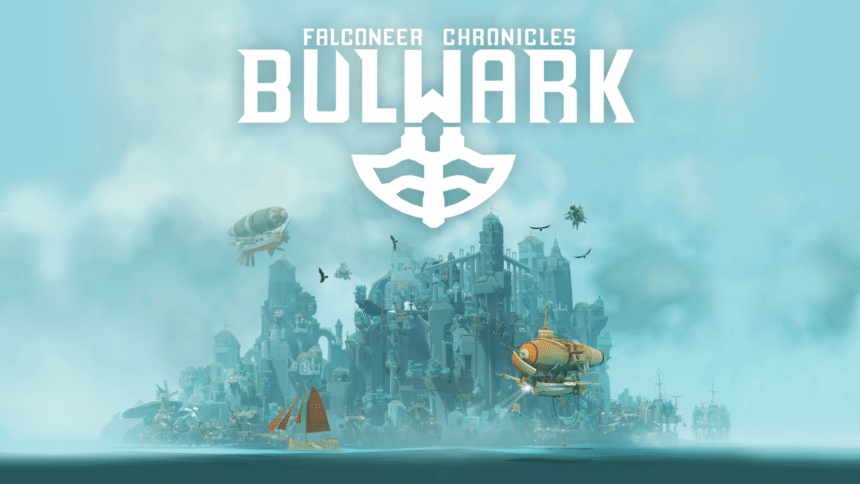City builders have always intimidated me, but I’ve slowly started to dip my toes into the genre, and I’m always on the lookout for something that has a unique hook. I’m already familiar with the work of Tomas Sala thanks to Falconeer, but Bulwark: Falconeer Chronicles is a different beast entirely. It’s a city-builder, but not really, and I had a chance to play a recent build to see what it has to offer.
Expand and Connect
Bulwark isn’t a traditional city-builder, and there’s no major penalty for expansion. You start with an outpost that serves as the center of your city, even if you don’t technically build around it. Everything starts from there, and you connect new structures to it through bridges. It reduces the limitations of a traditional city-builder because it doesn’t exactly account for terrain more deeply.

Getting used to the controls can be a bit tricky though. I spent a while trying to understand how exactly the connection line worked. Despite an actual guide NPC instructing you through these steps, I feel like the tutorial could do with a bit more hand-holding because these aren’t traditional camera controls that most PC users will be used to.
It took me a while to confirm that I had to press Space to build between structures because the instructions at the top of the screen didn’t explicitly mention that. After learning these though, I started to appreciate this simplified control scheme thanks to its context-sensitive approach.

Micromanagement isn’t the focus of Bulwark but rather creating a sprawling settlement that feels connected, alive, and aesthetically pleasing. The game likes to remind you that you aren’t making any mistakes, which is encouraging. The workers build different structures around bridges on their own as they expand their network. While the tech behind this expansion is quite impressive, it does make individual elements of your empire feel less personal.
Exploration and Defense
After going through the tutorial, I was allowed to explore the open world (open-sea) and do what I wanted. This part is done with an airship, and you’ll see points of interest on the map. You can fast-travel between important locations, and I ran into small islands with resource deposits, pirates, and refugees along the way. There is some minimal diplomacy here as well, and you can choose to engage in battle too.

Battles don’t give you active control of your units, though. You’ll see it play out depending on how much influence, and attack resources you have. You can choose to trade and use your influence in a non-violent way, but you’ll end up in battle one way or another. Being able to switch between exploration and ground mode is simple and intuitive. This allows me to engage with both systems at the same time.
Trade is done through harbor points, between your outpost and the resource location. You’ll have to appoint Commanders at the different posts to ensure your defense, and trade posts are in working shape. There is some basic decision-making here, and the game practically spells out the best fit for these positions.
Superb Presentation
Arguably, the strongest aspect of Bulwark is its excellent presentation. The world of Ursee is shrouded in open sea, and there’s beauty in every corner, starting at your Outpost itself. You can zoom all the way in to see each building meaningfully placed next to or atop each other, connected in a way that would make structural sense.

Every time you upgrade a tower, a small animation plays out, rebuilding and adding layers of stone, and wood. Connected lines turn into bridges that conquer land and sea with stone roads, lights, and windmills. The water is beautifully rendered, and you can see marine life reflected by the thunder of Bulwark’s many weather effects. Deep water is terrifying, especially when you have to venture far into the ocean to look for resources and life.
I enjoyed the soundtrack too, and there are plenty of neat sound effects that complement the gameplay. Characters are voice-acted as well, and you’ll even see the game’s created, Tomas Sala pop up in the main menu to provide some guidance on the journey ahead.
Closing Thoughts
So far, I’ve come away quite impressed with what I’ve played of Bulwark: Falconeer Chronicles. It’s a unique take on the city-builder genre that prioritizes expansion over resource management. The presentation is excellent, and I enjoyed seeing my tiny outpost grow into a large empire as I conquered land, air, and sea. The tutorial still needs some work, especially for PC players who prefer playing on a mouse and keyboard.
I’m looking forward to the final release, and really appreciate Tomas Sala’s engagement on Steam forums. They’ve been taking feedback from players with lengthy responses, and I think there are already some improvements in this based on that feedback.
You can add Bulwark: Falconeer Chronicles to your wishlist on Steam at the following link.
This preview is based on the PC version of Bulwark: Falconeer Chronicles. The key was provided by 1UP PR and Wired Productions.










